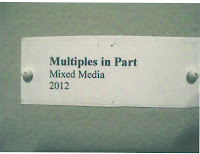This week, I visited the campus art gallery for my portfolio class, and on display were the works of one Debra Kayes.
I didn't really know much about Debra Kayes until I visited this gallery. Mrs. Kayes apparently works as an art and design teacher at Chicago's branch of Collumbia College and as an art major for MUZZLE Magazine. She also has a post-bachelor major Certificate for Graphic Design that she received in 2009, and a master's degree in fine arts, painting and sculpture.
I found the pieces she created to be fairly interesting. She describes the inspiration for her works as thus:
" I make use of simple organic forms to explore the ways in which creatures large and small group to gain safety in numbers. Layered and repeated elements allow individuals to act as one. Yet, through investigating patterning techniques like emergence, gang-mentality, and swarm theory, I have also found interest in the benefits of biodiversity, abnomaly, and metamorphosis. My approach intentionally forces me to be perceptive and open to change, with moments of hilarity, so I can discover modification and mutation, speaking to the fluid nature of groups quickly adapting based on local information."
Atlas of Men is mixed media , which would appear to be Mrs. Kayes' favorite method of creating art, comprised of wood and paint. I think what Kayes did with this piece was look at the cut of wood and see different, naturally-formed shapes as peoples' silhouettes, and colored them in.
I believe that the idea that Kayes is trying to convey here is camouflage; how animals blend in with their surroundings. I believe that the title itself ties into this theme in that people often try to conform to some standard, much like how an animal uses camouflage.
Multiples in Part, I think, was rather interesting, being made from folded up tissue paper and printer paper to resemble a reef of various corals. I believe that the title of this piece refers to how structures of coral come in separate groups, but are all connected in a way.
See/ Sea seemed like a very inexplicable piece, being various painted wooden blocks arranged in piles about the room. I feel that this relates to animals' methods of safety in numbers in that animals in large groups will often scatter about so that it will make it harder for a predator to get them. The title, I believe, refers to how this method is practiced mostly by marine animals, such as fish, and it makes them difficult to find.
This final piece, Account, I found to be the most interesting , being, at its core, a giant wall of paper hands that must have been exceedingly difficult to make them all exactly alike and arrange them as neatly as possible. In short: it seems simple, yet complex.
I believe that the theme of this piece is how large groups of similar-looking animals will come together as one to avoid being attacked by predators, who see them as bigger than they really are. The title alludes to importance and worth, which you would think a small creature would lack until a great number of them come together in a large group.














